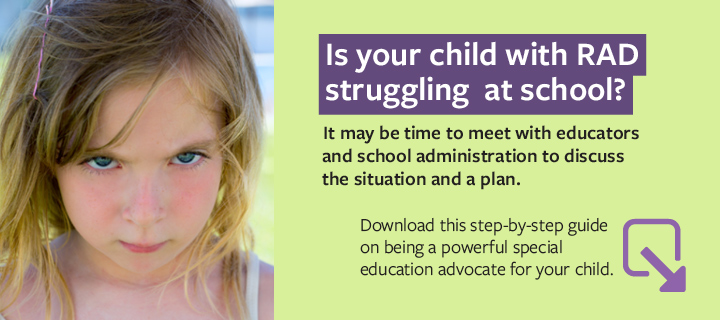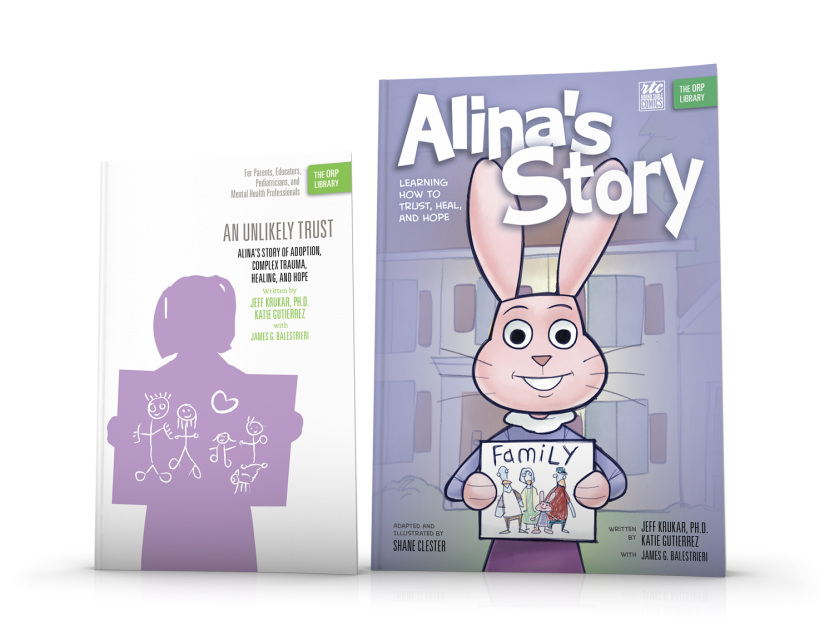Advocating for your Adopted Child with Complex Developmental Trauma
Written By: Aleksandra Corwin, Lizzie Vance
Resource Creation By: Bridget Morton, Keli McNeill
Design By: Sunny DiMartino, Nathan Lueth, Christy Bui
At a conference table at Nadya’s school, Karl, Nadya, and Lori* sat with the school principal, school psychologist, school social worker, special education director for the school district, and Nadya’s homeroom teacher, to review records and test results and to discuss Nadya’s future at the school.
Nadya had been adopted from Russia a little over six months earlier, and the Hetzels quickly realized that her needs far surpassed anything they’d been prepared for. They’d had to call 911 half a dozen times when her violent rages spiraled out of control. In the past two months, she had been institutionalized on an emergency basis in psychiatric hospitals four times, each stay lasting between three and seven nights. She had been prescribed a combination of strong psychotropic drugs, including anti-psychotic medication and pills for anxiety, depression, and attention deficit hyperactivity disorder (ADHD). The family hadn’t seen any major change in her behavior. The rages — the screaming and throwing household items for hours on end, the hitting, kicking, biting, and slamming doors all night — continued. The Hetzels were desperate to get help for their daughter, and reclaim a semblance of sanity for themselves.
Having worked in and around the adoption field for years, Lori knew that one of the first steps in getting Nadya the help she needed was to have the school district evaluate Nadya as a student with special education needs so they could develop and implement an Individualized Educational Plan (IEP). Thanks to the federal Individuals with Disabilities Education Act (IDEA), students with special education needs are entitled to the services and supports an IEP provides, such as individualized special education options, as well as modified instructional techniques and specialized materials. Nadya was nine years old when she was adopted, and had cognitive, social, and behavioral delays; she understood and spoke English at the level of a two-year-old, had poor memory skills, and had difficulty recognizing cause-and-effect relationships. Nadya’s school had been willing to generally evaluate her cognitive skills because it was difficult to accurately assess her learning. At school, she was usually passive and silent, as opposed to the highly reactive, easily angered child the Hetzels often experienced at home. Assessing her “true” functioning was difficult as her behavior was so variable and extreme.
Nadya had refused to get dressed earlier that day, spending the majority of the morning alternating between locking herself in the bathroom and coming out to scream and throw things at Lori. Somehow, Lori had successfully gotten the other three kids to school (albeit a little late), but her nerves were frayed and dark circles ringed her eyes as she sat there, sleep-deprived and feeling desperate.
She looked at each member of the school team assembled at the table.
“Thank you so much for coming,” the principal started. “We’ve reviewed her records and gone over the test results, and, well…” he faltered. “We’re not exactly sure what the best course of action is. We’ve never had a child quite like Nadya.”
The school psychologist spoke next. “To put it simply, we think Nadya’s main issue is that she doesn’t speak English. We think she needs English as a Second Language classes, or ESL first and foremost.”
It was as though all the oxygen had been sucked from the room. “Nadya not speaking English is not the issue,” Karl stammered. He and Lori both stared ahead in shock at the school psychologist’s statement, and what it might mean for their daughter’s education.
Lori jumped in. “We’ve been trying to teach her English for almost half a year now, and we’re not making progress.” She swallowed back the frustration. “She needs more individualized attention at school, and counseling or therapy — something. Something to teach her how to handle anger, and make her feel safe and comfortable. Only then will she start being able to learn anything.”
The principal nodded, but it didn’t seem as though he heard what Lori was saying. “Our school social worker and psychologist and the special education director agree that the best thing at this time is to put Nadya in ESL classes, through regular education, every morning for two hours, and assess her progress and the situation after she’s received instruction from a certified teacher for a period of time.”
“No, no,” Lori said, panic rising in her chest. “You’re not understanding me. She has complex developmental trauma because of what happened to her before she was adopted. She needs to work with someone who understands the issues related to that.”
Lori had been doing her reading and knew that some children like Nadya experienced repeated exposure to trauma — including things such as extremely poor care, severe abuse, or neglect — in early life. As a result, like Nadya, they may suffer not only from symptoms of a trauma or stress related disorder, like RAD, but also have characteristics of ADHD, post-traumatic stress disorder (PTSD), and developmental delays — all of which could be combined under an umbrella of “complex developmental trauma.”
“We appreciate her situation and how her past may have contributed to it,” said the school psychologist, an air of arrogance and professional distance in his voice. “But we think if we can get her to communicate properly first, it will alleviate a lot of the behavioral issues. Oftentimes we see that communication problems are the underlying cause of behavioral and emotional problems. It’s actually quite common in children with autism.”
“I’ve been studying with her every day.” Lori’s voice shook as her volume went up slightly, the desperation now weighing heavily on every word. “She is not just going to start speaking English because you put her in an ESL class. That is not the issue.”
The group of faculty members shifted, noticeably uncomfortable, and looked at each other.
“We understand your concerns,” said Nadya’s homeroom teacher. “We’d like to give this a try first and see how it works. To be honest, we just don’t know what else to do for her right now.”
What Lori didn’t have the clinical terminology for at the time — but which she understood intuitively as a mother and as someone who worked in the adoption field — was that Nadya’s brain seemed to have trouble acquiring any language. What she wished she had known then was how to explain that Nadya had probably missed an important window in early childhood when her brain was wiring itself for language and communication. If a child has not received the attachment, bonding, nurturance, and social interactions necessary for developmental progress and growth early in life, then the necessary neural connections don’t develop fully and the child may often face lifelong delays, including those associated with language and communication. Lori was sure that Nadya’s brain had spent most of its time in her early years more sensitive to threat and survival, frequently mobilizing itself for fight, flight, or freeze — all in a very adaptive sense. However, the cumulative impact of her early experiences also resulted in delays and underdeveloped skills necessary for relating, communicating, and thinking.
But Lori wasn’t a psychologist and was still learning how to be the best advocate she could be for her child. She sat there crumbling inside. She and Karl were on their own, with just their thoughts, fears, and anger, and no one to help them advocate for their little girl against the “system.”
Karl cut to the core of what they hoped to achieve from this meeting. “She needs to be evaluated for an IEP. We want an IEP. She needs individualized attention for issues other than just her language.”
“Well, to be perfectly honest,” answered the principal, “she’s legally not entitled to an IEP.”
“What?” Lori choked out. “Of course she is — according to the report from the psychiatrist in Texas, she is cognitively and emotionally disabled.”
“Oh, we know that, and believe me, we really want to help,” the principal said. “But actually, our state requires that a child be a U.S. citizen for three years before they become eligible for an IEP.
“What? That can’t be,” said Karl, stunned. The Hetzels had just moved their entire family across the country and back to their home state, where the public mental health services were supposed to be better, to try to find help for their traumatized little girl. They had also assumed the public school special education services were better. They were on a six-month waitlist to see a therapist at the International Adoption Clinic, and now the school was saying they wouldn’t help. The nightmare of this moment — these months — darkened the room around them, and Lori wiped the palms of her hands dryly against her thighs.
“We know she has needs, and we are going to do our best to accommodate her,” said the principal, “but again, we think this is what’s best for her right now.”
They looked at the Hetzels sympathetically, but Lori and Karl sat limply, like ragdolls, feeling completely hung out to dry.
“Unfortunately, our hands are tied because of state law,” the principal finished.
They can’t help our daughter; they don’t know what to do with her, Lori thought. She later learned that the law was geared toward children who had emigrated to the U.S. with their entire families, and so had legitimate ESL needs, but she felt this law shouldn’t apply to Nadya, who was clearly mentally disabled. These were supposed to be people Lori could count on to educate her child. Lori knew that if Nadya were put in a mainstream or even ESL classroom without extra help, she would spend most of her days sitting with her head down or staring out the window. Lori had seen how Nadya was becoming the class “mascot” who followed the students around from one activity to another, completely not understanding what was going on, and not learning anything either. The students were nice to her, and curious about her mute, distant presence — but this was no way for a child to go through school. How could the special education system designed to help children and families in this country be so hard to access?
Lori and Karl believed what they were being told — that there was nothing they could do for almost three more years. Lori felt intimidated and small and didn’t know how to respond, assuming their word was final. She walked out of the meeting with a mixture of anger, fear, and failure.
As the Hetzels later learned, having a child with special needs — of any kind, but especially with needs that span significant developmental delays — requires a sense of inner strength and bold determination to not take anyone’s no as the final word.
It took two and a half more years of rages accelerating in frequency, intensity, strength, and violence for Lori and Karl to get their daughter the special education services that allowed her to best learn the skills necessary to do well in school. It took equally as long to figure out they were entitled to have a special education advocate provided by the state at their side during these meetings with the school district. By that time, they also had Nadya’s therapist from the International Adoption Clinic, who specialized in traumatized children adopted from overseas, calling in to the quarterly meeting to advocate on Nadya’s behalf.
In hindsight, the Hetzels probably could have hired a lawyer to push the school to expend the appropriate resources for Nadya’s education. If the school wasn’t able to accommodate her in that particular setting, it was the district’s responsibility to fund her education somewhere that could. But at the time, the Hetzels knew none of this. They believed they were on their own.
Lori and Karl would go on to enroll Nadya at Genesee Lake School, a therapeutic residential school with a specialty in helping students with complex trauma, where she made progress and flourished for more than two years. When Nadya successfully transitioned home and to her local public middle school in sixth grade, she had appropriate IEP special education services and supports in place. She thrived and made gains academically, behaviorally, and socially.
The Hetzels hope that other parents can learn from their experience and save themselves years of frustration by learning their special education rights under IDEA - thoroughly and early.
*Lori Hetzel is the author of a forthcoming book about her family’s experiences adopting an older, traumatized child, due in spring 2015 as part of the MyPath Library of books on disabilities.

Sign Up to Receive New Posts
We promise not to spam you or share your information with anyone. And you can unsubscribe at any time . . . although we hope you stay a while!





